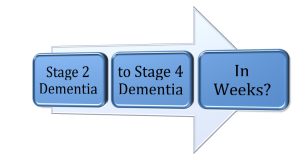
by Diane Masson | Jul 5, 2015
 Professionals have told me that a trauma could have caused Amy’s dementia (my favorite mother-in-law) to escalate rapidly. Is this true? Can all the dementia professionals and family members weigh in with their experiences?
Professionals have told me that a trauma could have caused Amy’s dementia (my favorite mother-in-law) to escalate rapidly. Is this true? Can all the dementia professionals and family members weigh in with their experiences?
My mother-in-law’s dementia was progressing slowly like my mom’s vascular dementia. There are four stages of memory loss and Amy was in stage 2, before the trauma. She repeated herself a lot, needed cueing for personal hygiene, medication management and had little desire to leave the home. Amy talked about not being able to remember stuff, but she could still read the paper, dress, bathe, toilet and feed herself.
Then Bill, my favorite father-in-law and Amy’s 24-7 caretaker, had a heart attack and went to the hospital. Amy could not understand where her rock and husband of 65 years had gone. She ended up having a psychotic break and eloping (The police had to find her and bring her back home.). A whole series of dramas happened and she hit a nurse. Then she too was hospitalized and put on psychotropic medications. Amy was in the hospital for three weeks in the psych ward.
By the time she got out of the hospital, the Amy I had seen months earlier was gone. The first time my husband and I saw her after the hospitalization (we live three states away) was so sad. The vivacious and sarcastic Amy was gone. It was like seeing a shell of her former self. Her lip trembled, her arm shook and she was so sleepy from the Haldol drugs. We immediately got the psychotropic medication reduced by half. It took us another three months to get her completely off the Haldol because we are not Amy’s Power of Attorney.
Amy was suddenly in stage 4 dementia. She needs help with absolutely everything and is not able to communicate her thoughts or needs. Hospice has been discussed in care plan meetings.
Has anyone else seen such a rapid decline with a family member or resident with dementia? Was it losing her husband, the psychotropic medications or both that caused Amy’s rapid deterioration? I believe that if my in-laws had planned ahead and moved into a Continuing Care Retirement Community (CCRC) that staff and residents would have supported Amy when her husband was first hospitalized. The CCRC would have rallied around her, helped her transition to the care level she needed and her world wouldn’t have changed so dramatically (she would have been dining daily with resident friends instead of being isolated in her own home).
What do you think?
“Your Senior Housing Options,” has a simplistic title, but what’s inside this new book can save a you months of research time. Hear Diane Masson’s interview of how her mother and in-law’s faced the pivotal decision to plan ahead or wait until a crisis. Learn the pitfalls from transitioning from your home to senior housing. Understand what questions to ask, insider tips and dirty secrets revealed. The decision to stay home requires caregivers. Prevent elder abuse by determining if a home care agency is reputable, before they move into your home. You are just not looking for today’s needs, but for your future care. Discover key differences between rental facilities vs Continuing Care Retirement Communities. Do you have enough financial resources if you need to be in a higher level of care for an extended period of time? For weekly tips join at: Www.Tips2Seniors.com
Diane Masson has worked in senior housing for 17 years and is the regional marketing director for two debt-free Continuing Care Retirement Communities in Southern CA (Freedom Village in Lake Forest and The Village in Hemet). Her first book “Senior Housing Marketing – How to Increase Your Occupancy and Stay Full,” is being utilized by senior housing professionals across the country. Both her first book and second book, “Your Senior Housing Options,” have a 5-star rating on Amazon.com.

by Diane Masson | Jun 14, 2015

UN-ENGAGED EMPLOYEES HAVE CRACKS THAT NEED REPAIR!
Is there a crack in your armor? Are you living on empty and have nothing left to give your family or job? Maybe you are a full-or part-time caregiver for an aging parent or a senior with dementia? Perhaps you are in a senior living sales slump?
You can’t help anyone else or be productive at work unless you take care of yourself first. Look for joy in the moments. You may be going through a dire time. Maybe your parent or one of your senior patients is dying. Perhaps your daughter or son has some kind of health or school trauma. Possibly you just learned that someone scheduled to move into your retirement community has changed his or her mind. It may have been the one you needed to hit your sales goal this month. Sigh…they are going to stay home and wait for a crisis. You start asking why over and over.
Don’t become jaded and harden yourself with a giant wall to protect your emotions. It’s mentally checking out and called un-engagement. Your family, senior prospective residents and coworkers can feel your wall.
If you work in senior living sales, we can’t help every senior. Only the ones who choose to plan ahead. Do you feel overwhelmed with what’s happening in your personal life? Is your lack of sales getting you down? Well it’s time to go find your rainbow. Are you wondering how to get started? Feed your mind with positive thoughts. Schedule time to heal yourself!
10 Recharging Tips:
- Go to a live concert, stand in your shower or drive down the road singing at the top of your lungs.
- Sit by the ocean and wiggle your toes in the sand.
- Fly down the road with the wind in your face on a bike or motorcycle.
- Hold a baby or play with small children.
- Take a Saturday to read a book.
- Hang out with your friends.
- Spend time in nature – amongst the trees, watching the river go by or gazing at a lake.
- Soak in a bubble bath surrounded by candles.
- Go to a sports game in person. Cheer on your favorite team.
- Build a fire and make s’mores!
Recharge today, so you can change your world one senior or family member at a time.
Let your family and job see your heart when you speak. They will be moved and feel your sincerity. Seniors can tell if you want what’s best for them. Suddenly seniors who were “not ready yet” become ready to move into your retirement community. Conviction in your voice can move a mountain.
Shake off the negative. Don’t focus on the junk. I created a spiritual foundation of faith that can sustain me when I have a tough day. You can too. We all have moments of weakness. Believe in your ability to change a senior’s or family member’s life today.
In every encounter with family or at work, we either give life or drain it.
Do you give life to those around you at work and at home? Are you so worn out from working that you have nothing left to give your family? It’s your choice to be a giver or taker to those around you. Have you taken time to recharge yourself recently?
Exciting news! Diane’s CCRC teams are breaking records and hitting aggressive occupancy goals this quarter. They all participate in a weekly book review led by Diane. The book review helps the teams stay on track, improve sales skills and build team camaraderie. They just completed learning the 12 keys in Senior Housing Marketing: How to Increase Your Occupancy and Stay Full for senior living professionals. It was written by Diane Twohy Masson.
Credit to Gallop: Only 30.5% of employees are engaged at work.
Everyone of us knows at least one senior that needs to move now. Here is a resource to help you or them make an informed decision. Diane Twohy Masson’s new guide book for seniors, “Your Senior Housing Options,” is available on Amazon.com with a 5-star rating. It reveals a proactive approach to navigating the complex maze of senior housing options. It will help you understand the costs and consequences of planning ahead or waiting too long. Learn firsthand tips from someone who is currently advocating for two aging parents.
Among the thousands of seniors she and her teams have assisted in finding the right senior living community, the most difficult case has been helping her own parent. Masson spent two years exploring senior housing options with her mother before finding the ideal Continuing Care Retirement Community for her. After eight years in this independent living setting, she helped her mother transition into an assisted living community. Seven years later, even as a senior housing expert, Masson struggled with the decision to move her mother into a skilled nursing community.
More related articles by Diane can be found at Tips2Seniors.com or like Tips 2 Seniors on Facebook.

by Diane Masson | Apr 27, 2014
 Many senior living communities say, “We will take care of you for the rest of your life.” Really? What if a senior legitimately runs out of his or her resources? Can they still stay for life? Is it a marketing spiel or a real guarantee? What promise is really written in the resident’s contract? Do they offer at least three levels of care including skilled nursing?
Many senior living communities say, “We will take care of you for the rest of your life.” Really? What if a senior legitimately runs out of his or her resources? Can they still stay for life? Is it a marketing spiel or a real guarantee? What promise is really written in the resident’s contract? Do they offer at least three levels of care including skilled nursing?
Senior living communities can talk about a “fund” to help residents or a “Good Samaritan Fund.” My own mom was lucky enough to benefit from this type of fund. I never dreamed in a million years that my mom would live in a higher level of care like assisted living for so many years (seven to be exact). In the middle of those seven years, my mom ran out of her resources. She has social security, an annuity, a pension and a savings account. Her savings account depleted down to $2,000.
Thank goodness my mom’s Continuing Care Retirement Community (CCRC) had a Good Sam Fund that was developed out of generous donations. The little known fact was that only 10 seniors could benefit from the fund at any given time. My mom was number 10. I never knew if there was a resident whose number was 11 or higher that never received financial help.
Now, I know about two CCRC’s in CA that offer a Guarantee of Care for life. It is straight up and clearly written in the contracts at Freedom Village in Lake Forest and The Village in Hemet.
An attorney compared CCRC contracts in Orange County and determined that all were not equal in the guarantee of care for life. Some are straight up and others offer, “A guarantee of care for life,” but add three extra words following this statement in the contract… those three extra words are, “At our option.”
“At our option,” sounds a lot like a Good Sam Fund that has a limited amount of resident users. What do you think?
Please share your successes, failures or comment below to join the conversation and interact with other senior living professionals on what is currently being effective to increase occupancy on a nationwide basis.
Diane Twohy Masson is the author of “Senior Housing Marketing – How to Increase Your Occupancy and Stay Full,” available at Amazon.com with a 5-star rating. The book is required reading at George Mason University as a part of its marketing curriculum. Within this book, the author developed a sales & marketing method with 12 keys to help senior living providers increase their occupancy. Masson developed this expertise as a marketing consultant, sought-after blogger for senior housing and a regional marketing director of continuing care retirement communities in several markets. She has also been a corporate director of sales and a mystery shopper for independent living, assisted living, memory care and skilled care nursing communities in multiple states. Currently, Masson is setting move-in records as the regional marketing director of two debt-free Continuing Care Retirement Communities in Southern California – Freedom Village in Lake Forest and The Village in Hemet, California. Interestingly, this career started when she was looking for a place for her own mom and helped her loved one transition through three levels of care.
© Marketing 2 Seniors| Diane Twohy Masson 2013 All Rights Reserved. No part of this blog post may be reproduced, copied, modified or adapted, without the prior written consent of the author, unless otherwise indicated for stand-alone materials. You may share this website and or it’s content by any of the following means: 1. Using any of the share icons at the bottom of each page. 2. Providing a back-link or the URL of the content you wish to disseminate. 3. You may quote extracts from the website with attribution to Diane Masson CASP and link https://www.marketing2seniors.net For any other mode of sharing, please contact the author Diane Masson.

by Diane Masson | Nov 10, 2013
 There were such a variety of responses to “How Many Calls Does Your Senior Living Team Make Per Month,” I am choosing to expound with a more in-depth part 2. Senior living sale professionals responded with call requirements from 20 calls an hour to 40 completed calls per week. Someone else’s retirement community had mandated 53 connected calls per month.
There were such a variety of responses to “How Many Calls Does Your Senior Living Team Make Per Month,” I am choosing to expound with a more in-depth part 2. Senior living sale professionals responded with call requirements from 20 calls an hour to 40 completed calls per week. Someone else’s retirement community had mandated 53 connected calls per month.
Here is one response:
“Diane, I have enjoyed reading your blogs on seniors, which are informative with best practices. This one on “How Many Calls A Month” made us gasp with the large number of calls a sales team is expected to make nowadays. 500 to 1,000+ calls a month must be only cold calling behind a closed door and doing nothing else like sales events, tours, refurbishment oversight, building relationships with future residents, community and church relations, follow up on leads and inquiries, application process, and administrative team projects.” Nancy
My response: These calls were not cold calls, so here is a more detailed explanation.
My example in part one had a marketing director with 469 calls and her two team mates with 340 and 315 calls respectively. These sales calls included: call-ins, voice-to-voice call-outs and left messages. I believe if someone leaves a great message, seniors will call back. Our requirement is 75 calls a week or 300 per month. This is not one isolated goal. Another goal is 20 initial or repeat tours per month. This tour goal does not include post-closing appointments after a deposit has been taken.
Yes, these senior living sales people have other responsibilities including three events per month (all day), responding to Internet inquiries, weekly strategy meetings, book reviews, overseeing apartment renovations for their clients, and managing his or her move-ins (paperwork, relationship building, setting up health assessments, family tours and etc.).
If you don’t have sales and occupancy goals, then no one has a pinnacle to reach. This team produced five Continuing Care Retirement Community (CCRC) sales in the last eight days. They have hit the quarterly move-in goals this year and are currently close to hitting the fourth quarter goal and going to Disneyland. This year, they have produced the most CCRC move-ins at their retirement community since 2005.
Please share your call, tour and move-in quotas to converse with other senior living sales professionals. Let’s hear about the variety of quotas out there. It will also be interesting to know if you are hitting your move-in goals based on your calling goals.
Please share your success, failures or comment below to join the conversation and interact with other senior living professionals on what is currently being effective to increase occupancy on a nationwide basis.
Diane Twohy Masson is the author of “Senior Housing Marketing – How to Increase Your Occupancy and Stay Full,” available at Amazon.com with a 5-star rating. The book is required reading at George Mason University as a part of its marketing curriculum. Within this book, the author developed a sales & marketing method with 12 keys to help senior living providers increase their occupancy. Masson developed this expertise as a marketing consultant, sought-after blogger for senior housing and a regional marketing director of continuing care retirement communities in several markets. She has also been a corporate director of sales and a mystery shopper for independent living, assisted living, memory care and skilled care nursing communities in multiple states. Most recently Masson was recruited to consult for two debt-free Continuing Care Retirement Communities in Southern California – Freedom Village in Lake Forest and The Village in Hemet, California. Interestingly, this career started when she was looking for a place for her own mom and helped her loved one transition through three levels of care.
© Marketing 2 Seniors| Diane Twohy Masson 2013 All Rights Reserved. No part of this blog post may be reproduced, copied, modified or adapted, without the prior written consent of the author, unless otherwise indicated for stand-alone materials. You may share this website and or it’s content by any of the following means: 1. Using any of the share icons at the bottom of each page. 2. Providing a back-link or the URL of the content you wish to disseminate. 3. You may quote extracts from the website with attribution to Diane Masson CASP and link https://www.marketing2seniors.net For any other mode of sharing, please contact the author Diane Masson.

by Diane Masson | Nov 3, 2013
 Recently, I received an email from retirement counselor at a four-year-old Continuing Care Retirement Community (CCRC) in California. He talked about being busy making 500 calls per month. I asked if that was 500 calls for just himself or was it 500 calls for the team of three senior living sales people? The answer was 500 calls for the entire team.
Recently, I received an email from retirement counselor at a four-year-old Continuing Care Retirement Community (CCRC) in California. He talked about being busy making 500 calls per month. I asked if that was 500 calls for just himself or was it 500 calls for the team of three senior living sales people? The answer was 500 calls for the entire team.
Just an FYI for administrators and senior living sale people – 500 calls for a senior living sales team of three is not great. Each retirement counselor should be personally generating 300 calls or more in order to increase the occupancy.
We track database calls with all my senior living sales teams. For the month of October, one of my CCRC marketing directors rocked with 469 calls. Even with all her responsibility, she set the pace. One of the retirement counselors generated 340 calls and another made 315 calls. These three team members produced 1,124 calls in one month! This included inbound and outbound calls. This CCRC team is one of the hardest working teams that I have ever encountered.
What is the result? Tours, tours and tours! What comes from tours? Move-ins! Move-ins increase your occupancy and generate revenue. How many calls are you and your teams creating per month? Do you track it? You should!
Please share your success, failures or comment below to join the conversation and interact with other senior living professionals on what is currently being effective to increase occupancy on a nationwide basis.
Diane Twohy Masson is the author of “Senior Housing Marketing – How to Increase Your Occupancy and Stay Full,” available at Amazon.com with a 5-star rating. The book is required reading at George Mason University as a part of its marketing curriculum. Within this book, the author developed a sales & marketing method with 12 keys to help senior living providers increase their occupancy. Masson developed this expertise as a marketing consultant, sought-after blogger for senior housing and a regional marketing director of continuing care retirement communities in several markets. She has also been a corporate director of sales and a mystery shopper for independent living, assisted living, memory care and skilled care nursing communities in multiple states. Most recently Masson was recruited to consult for two debt-free Continuing Care Retirement Communities in Southern California – Freedom Village in Lake Forest and The Village in Hemet, California. Interestingly, this career started when she was looking for a place for her own mom and helped her loved one transition through three levels of care.
© Marketing 2 Seniors| Diane Twohy Masson 2013 All Rights Reserved. No part of this blog post may be reproduced, copied, modified or adapted, without the prior written consent of the author, unless otherwise indicated for stand-alone materials. You may share this website and or it’s content by any of the following means: 1. Using any of the share icons at the bottom of each page. 2. Providing a back-link or the URL of the content you wish to disseminate. 3. You may quote extracts from the website with attribution to Diane Masson CASP and link https://www.marketing2seniors.net For any other mode of sharing, please contact the author Diane Masson.

by Diane Masson | Oct 27, 2013
 Do your residents speak at your senior living community’s events? Are you afraid of what they might say? If you don’t let residents speak, then your senior attendees are missing out. How can seniors really know what it is like to live at a retirement community or assisted living? The most effective way is for them to hear it from a peer.
Do your residents speak at your senior living community’s events? Are you afraid of what they might say? If you don’t let residents speak, then your senior attendees are missing out. How can seniors really know what it is like to live at a retirement community or assisted living? The most effective way is for them to hear it from a peer.
Yesterday, I had a fabulous resident speaker at the Oktoberfest event for Freedom Village in Lake Forest, Ca. Richard spoke from the heart for about four minutes. His opening line was, “Welcome to my home.” He explained why he, his wife Barbara and Lily (his Chihuahua) moved to a Continuing Care Retirement Community (CCRC).
Richard shared some cute stories including when his wife initially tried the food at Freedom Village. She had declared, “The food is delicious and we are moving here.” He also said, “I was walking through my apartment the other day and just stopped to tell my wife, how happy that I am living here at Freedom Village.” He retired from law enforcement and explained why he felt very safe and secure at his retirement community. He mentioned volunteering at the local hospital and how you can live any kind of life you want. Sometimes he just enjoys reading a book in his apartment and at other times he has the opportunity to be social at dinner or at events.
I had no clue what Richard would say. Was it a risk? Yes! But it is important to make your best guess selecting a resident to speak at your senior living event. Richard and his wife are very active at the CCRC and embrace life with vigor and vitality. Richard’s testimonial was pivotal to some guests deciding to make Freedom Village their future home. In the past, I have had residents speak too long and had to gently nudge them to end. What are your experiences?
Do you want more information on how to put on a great event? Click on this link for a previous blog post I wrote about 8 Keys to Create Compelling Events that Drive Sales in Senior Living.
Please share your success, failures or comment below to join the conversation and interact with other senior living professionals on what is currently being effective to increase occupancy on a nationwide basis.
Diane Twohy Masson is the author of “Senior Housing Marketing – How to Increase Your Occupancy and Stay Full,” available at Amazon.com with a 5-star rating. The book is required reading at George Mason University as a part of its marketing curriculum. Within this book, the author developed a sales & marketing method with 12 keys to help senior living providers increase their occupancy. Masson developed this expertise as a marketing consultant, sought-after blogger for senior housing and a regional marketing director of continuing care retirement communities in several markets. She has also been a corporate director of sales and a mystery shopper for independent living, assisted living, memory care and skilled care nursing communities in multiple states. Most recently Masson was recruited to consult for two debt-free Continuing Care Retirement Communities in Southern California – Freedom Village in Lake Forest and The Village in Hemet, California. Interestingly, this career started when she was looking for a place for her own mom and helped her loved one transition through three levels of care.
© Marketing 2 Seniors| Diane Twohy Masson 2013 All Rights Reserved. No part of this blog post may be reproduced, copied, modified or adapted, without the prior written consent of the author, unless otherwise indicated for stand-alone materials. You may share this website and or it’s content by any of the following means: 1. Using any of the share icons at the bottom of each page. 2. Providing a back-link or the URL of the content you wish to disseminate. 3. You may quote extracts from the website with attribution to Diane Masson CASP and link https://www.marketing2seniors.net For any other mode of sharing, please contact the author Diane Masson.

 Professionals have told me that a trauma could have caused Amy’s dementia (my favorite mother-in-law) to escalate rapidly. Is this true? Can all the dementia professionals and family members weigh in with their experiences?
Professionals have told me that a trauma could have caused Amy’s dementia (my favorite mother-in-law) to escalate rapidly. Is this true? Can all the dementia professionals and family members weigh in with their experiences?




